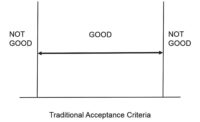The gage is from Company X, another gage is from Company Y and the software is from Company Z, yet they will not “talk” to each other. Before scrapping either of the gages or the software, explore the option of gage-interface systems.
A gage interface is actually two devices: a protocol converter that converts the proprietary output from a variety of gages to a standardized output, RS232, which is easily connected to any PC, says Dan Sternbergh, president of Midwest Flex-Systems Inc. (Flint, MI). The other component, he adds, is a multiplexer that takes more than one device at a time and converts the data to a single output.
“The interface allows a variety of instruments to be plugged in at a time and controls the flow of the data to the PC, so the PC can either ask for information from the interface or the interface can give the information to the PC,” says Sternbergh.
A complete gage interface system also includes some type of gage, some of which could be a micrometer, caliper, indicator or digital probes.
Hardware
With a variety of instruments to choose from, Sternbergh explains that the type of device that is being connected, how many devices are being placed at a single workstation and how far apart the devices are placed impact how a system will be set up.Sternbergh says that not all devices in an interface system can work at long distances. If that is needed, he suggests stacking interfaces together. “Our interface has a pass-through port so we can connect one interface to another to another to another and continue to do that. The intelligence is built in, so if two four-channel gage models are hooked together, the second four automatically become inputs five through eight, and if you plug another eight on top of that, those become nine through 16, and so on, up to 99 inputs.” The interface also brings multiple cables together, eliminating the need for long specialty cables to run across a workstation.
Sternbergh says while his company’s interfaces allow for up to 99 inputs, it is unlikely anyone would want to have that many at a single workstation. Output would not be a problem either because the flow of the data is controlled by the gage identifier. “Gage interface will not only convert the data, but we put a channel number and gage identifier on it that lets the software decipher which gage that reading came from so it can be assigned to the correct part characteristic in the software,” Sternbergh explains. “All of the different interfaces control the flow of data between each other. We can actually continuously send data from all of those inputs. The number of gages isn’t a problem because we identify it to the software.”
Robert Brown, program manager with the MeasurLink development team at Mitutoyo America Corp. (Aurora, IL) says when deciding on a system, it is necessary to understand the critical dimensions of the part because that determines the form of the gage.
“The next question would be to determine what the tolerance of those dimensions are in order to determine the resolution of the gage,” Brown explains. “After you’ve determined that, then you can talk about a configuration, which is to say what types of interface devices are required and what are the software needs.”
Software
Sternbergh’s company has the ability to collect data into any software because “the concept we have is a universal input to a standardized output regardless of the type or speed of the incoming data,” he explains. “We modulate that to a standard output so that any software will be able to capture the data, whether we’re hooked to a coordinate measuring machine, an indicator or to a weigh scale—the output out of our device will always be the same.”The input is handled directly or intelligent cables decode the outcoming data from a gage and convert it to a standardized input into the interface.
Brown adds that the software that is chosen will be determined by what one wants to do with the data. He suggests that a spreadsheet will be appropriate for some companies, while others may require a real-time feedback system in the form of an operator display. In others still, they may actually want to do tool compensation. In other words, take data automatically from the system and feedback to the machining center for tool-wear compensation. Brown explains that the chosen software “depends on the level of sophistication of an end-user need.”
Some things to look for in software are acquisition functions, display functions and other processing functions. One example that Brown gives is an application by a company that wants to use the data taken from a digital gage to analyze a specific characteristic of a part for dimensional analysis.
Some options include having the data time-stamped, traceability of the data such as serial or machine number or operator name, or the ability to see the raw observations. Having the results displayed in a histogram, control chart or run chart are other options to consider. Brown suggests the software have the ability to filter and merge data, and then in a factory-wide implementation, have the ability to pool the data into a centralized database in a networked environment.
“Other than that, you may want to perform mathematical calculations on data,” Brown says. “As an example, when measuring a block, I get length, width and height, but I really want to track volume, so I may want some higher level math applied to the observation data.”
Another aspect to keep in mind when it comes to digital data acquisition is the way in which data can be acquired. Some methods include:
- Send button on the gage itself
- External trigger, such as a footswitch
- Poll the data, which is a request, such as pressing a space bar on a keyboard
- Automate the data with timed requests, for example, every 10 seconds
The type of gage to be used, the way the data is to be collected and how the flow of data is to be controlled all impact a gage-interface system. “The big thing is that gage interface is an invisible but integral part of the system,” concludes Sternbergh. Q
Tech Tips
- A gage interface is actually two devices: a protocol converter and a multiplexer.
- In digital data acquisition, there are typically four ways to get the data: a send button on the gage itself, an external trigger, polling the data and automating the data.
- The system chosen will be determined by the level of sophistication of the end-users’ needs.

